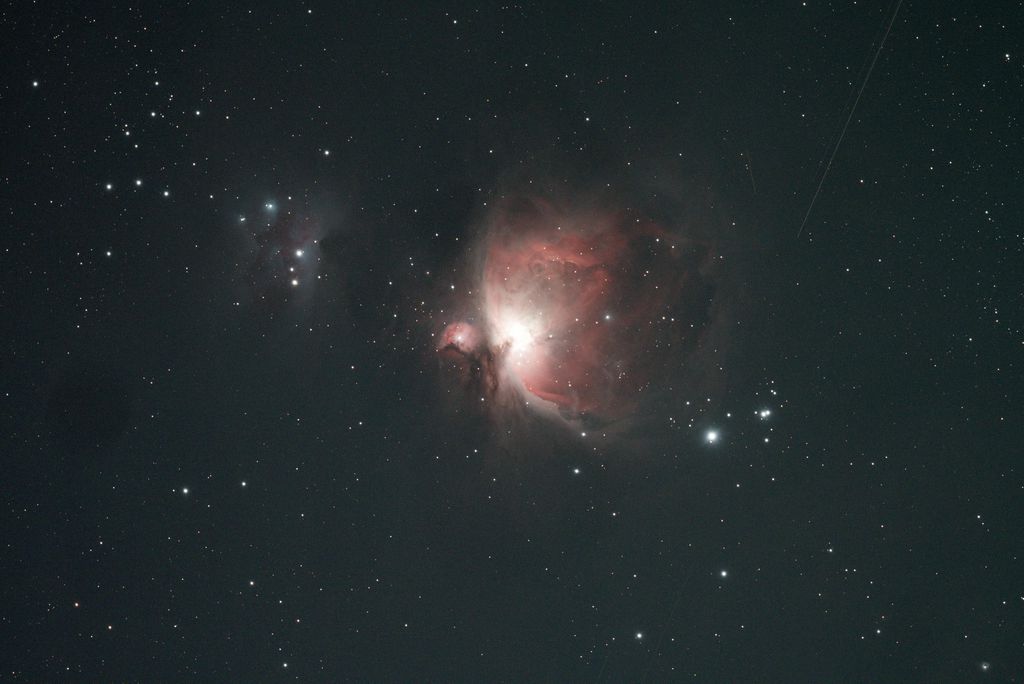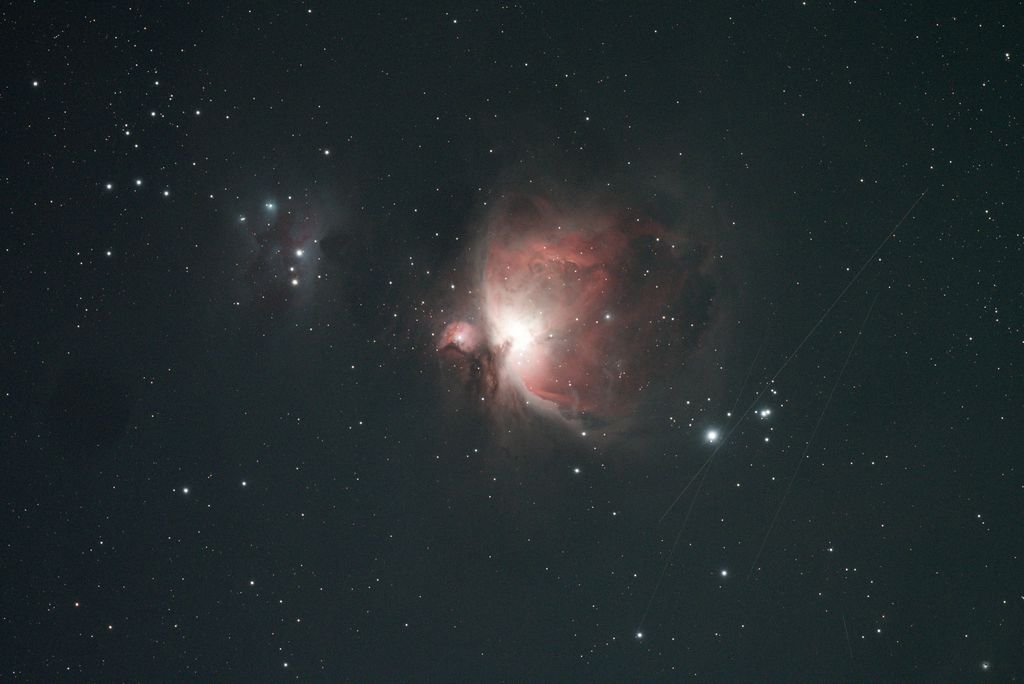I am pretty sure these are all satellite trails, but they are of differing brightness. Maybe some other artifact? The dim ones all seem to be in the same place, which makes me wonder if they are satellites or some going on with my camera/telescope...
Does anyone know what these streaks are, the bright one is obviously a satellite. These are the original 180" subs, straight out of the ASI2600MC. No processing or calibration.. I also think I probably overexposed the highlights as the center of the nebula is too bright..
Thanks,
Jerry    |
You cannot like this item. Reason: "ANONYMOUS".
You cannot remove your like from this item.
Editing a post is only allowed within 24 hours after creating it.
You cannot Like this post because the topic is closed.
Images one and three have multiple parallel trails -my first reaction is that these are set of SpaceX Starlink or similar communications satellites. These will become increasingly common with time.
Ed
|
You cannot like this item. Reason: "ANONYMOUS".
You cannot remove your like from this item.
Editing a post is only allowed within 24 hours after creating it.
You cannot Like this post because the topic is closed.
Ed Beshore:
Images one and three have multiple parallel trails -my first reaction is that these are set of SpaceX Starlink or similar communications satellites. These will become increasingly common with time.
Ed
*I guess shooting much later in the evening might reduce the sun's reflection on the increasing number of satellites orbiting the planet.
How do experienced astrophotographers deal with these nuisances? Is PixInsight the best software for removing them?
I hope that as the number of satellites continues to increase the software will get better and better at removing them.
|
You cannot like this item. Reason: "ANONYMOUS".
You cannot remove your like from this item.
Editing a post is only allowed within 24 hours after creating it.
You cannot Like this post because the topic is closed.
|
Just about any stacking software will remove these trails. Some leave faint impressions, depending on the settings. But mostly, once set, they go away. Not sure if the settings that make them disappear completely also cause other problems, but I have come to ignore them. Even when blinking the subs for paring. I will remove subs that have airliners lights rip across the field.
|
You cannot like this item. Reason: "ANONYMOUS".
You cannot remove your like from this item.
Editing a post is only allowed within 24 hours after creating it.
You cannot Like this post because the topic is closed.
Pixinsight and other software can be pretty effective at removing these. Image integration in PI can reject anomalously high pixels using a number of algorithms (sigma clipping, for instance).
One trick is to take enough subs that you might be able to eliminate those frames entirely. In the case of M42, you probably want to keep your subs short anyway to avoid blowing out the bright center of the nebulae. That means you can have plenty of subs and throwing a few away are usually not a problem.
Good luck, Ed
|
You cannot like this item. Reason: "ANONYMOUS".
You cannot remove your like from this item.
Editing a post is only allowed within 24 hours after creating it.
You cannot Like this post because the topic is closed.
Jerry Gerber:
Ed Beshore:
Images one and three have multiple parallel trails -my first reaction is that these are set of SpaceX Starlink or similar communications satellites. These will become increasingly common with time.
Ed
*I guess shooting much later in the evening might reduce the sun's reflection on the increasing number of satellites orbiting the planet.
How do experienced astrophotographers deal with these nuisances? Is PixInsight the best software for removing them?
I hope that as the number of satellites continues to increase the software will get better and better at removing them.
Yes they are satellites, Orion is a very transited area.
The good news is that at least in PI the pre processing algorithms take care of them. I don't even think about them.
|
You cannot like this item. Reason: "ANONYMOUS".
You cannot remove your like from this item.
Editing a post is only allowed within 24 hours after creating it.
You cannot Like this post because the topic is closed.
|
They are geostationary satellites. Orion is in the background of their orbits as seen from mid northern latitudes.
|
You cannot like this item. Reason: "ANONYMOUS".
You cannot remove your like from this item.
Editing a post is only allowed within 24 hours after creating it.
You cannot Like this post because the topic is closed.
Tim McCollum:
They are geostationary satellites. Orion is in the background of their orbits as seen from mid northern latitudes.
Hi Tim -
If they are geostationary why are they moving in straight lines? I would think that geostationary sats would be just that - stationary. This is why ground stations don't have to track them, they can just point at fixed locations in the sky.
|
You cannot like this item. Reason: "ANONYMOUS".
You cannot remove your like from this item.
Editing a post is only allowed within 24 hours after creating it.
You cannot Like this post because the topic is closed.
Ed Beshore:
Ed Beshore#19 minutes ago· 4 views
Tim McCollum:
They are geostationary satellites. Orion is in the background of their orbits as seen from mid northern latitudes.
Hi Tim -
If they are geostationary why are they moving in straight lines? I would think that geostationary sats would be just that - stationary. This is why ground stations don't have to track them, they can just point at fixed locations in the sky.
Ed,
You are correct in that if you point your telescope toward a geostationary satellite, it will not appear to move in the FOV of a stationary mount, however, all of the background stars, nebulae, etc. will move. The OP was taking a shot of the Orion Nebula clearly using a tracking mount, so the nebula appears stationary, but when tracking, anything that was stationary, for example any foreground tree or even a geostationary satellite, would move in a straight line out of the FOV over time.
To demonstrate, point your untracking telescope to a geosynchronous satellite and it will indeed stay stationary while all the stars move through the FOV. Now turn on the tracking - the stars stop moving and the geostationary satellite moves out of the FOV in a straight line.
Ron
|
You cannot like this item. Reason: "ANONYMOUS".
You cannot remove your like from this item.
Editing a post is only allowed within 24 hours after creating it.
You cannot Like this post because the topic is closed.
Agree with everyone these are nuisance satellite trails - PI does a really nice job of removing during pre-processing. I never delete these subs anymore, but agree with removal of large/bright airline trails. In my limited experience, very occasionally a very bright/thick satellite trail is not completely removed through default settings in WBPP. When this has happened, I tweak the Large-scale pixel rejection High settings, setting Large-scale layers to 1 and Large-scale growth to 2. In WBPP, you can find it under Integration Parameters in the Lights tab in WBPP.  |
You cannot like this item. Reason: "ANONYMOUS".
You cannot remove your like from this item.
Editing a post is only allowed within 24 hours after creating it.
You cannot Like this post because the topic is closed.
Ed Beshore:
Tim McCollum:
They are geostationary satellites. Orion is in the background of their orbits as seen from mid northern latitudes.
Hi Tim -
If they are geostationary why are they moving in straight lines? I would think that geostationary sats would be just that - stationary. This is why ground stations don't have to track them, they can just point at fixed locations in the sky.
This gets brought up quite a bit and is an easy mistake to make.
Geostationary satellites are fixed to a point on the ground. Hence the name. When imaging, you are fixing your camera/scope to a very distant point in the sky. The earth and the satellite in geosynchronous orbit are rotating together. This is why you see Orion rise in the east and then set in the west. It isn't really moving (well, it is, but for the sake of this discussion, its movement is so inconsequential, it is 0)... it is you and the earth and those satellites that are rotating at about 15 degrees per hour.
Here's a fun experiment for you to try. Find the coordinates for a geostationary satellite. Slew your mount to those coordinates, but do not start tracking. Now, take an image... maybe a 3 minute exposure. You'll see plenty of stars trailing across your image... but that satellite will stay pinned right there in the center. Turn on tracking and take another 3 minute exposure. The stars will be points, but that satellite will streak across your image.
|
You cannot like this item. Reason: "ANONYMOUS".
You cannot remove your like from this item.
Editing a post is only allowed within 24 hours after creating it.
You cannot Like this post because the topic is closed.
Yup- that makes sense.. Thanks to Ron And Jonny for setting me straight and apologies to Tim!
Ed
|
You cannot like this item. Reason: "ANONYMOUS".
You cannot remove your like from this item.
Editing a post is only allowed within 24 hours after creating it.
You cannot Like this post because the topic is closed.
Many a night I have been looking at Orion with just my eyes and see a flash that repeats about every 13 seconds then train my binoculars on it.
What I was seeing was a geostationary satellite creating a sun glint as it was spinning. Most all geostationary satellites are spin stabilized.
The actual satellite core is de-spun so as to keep its antennas pointed at a fixed spot on the Earth, only the solar panels spin.
This bright glint only last for about a minute as the sun angle changes.
Tim
|
You cannot like this item. Reason: "ANONYMOUS".
You cannot remove your like from this item.
Editing a post is only allowed within 24 hours after creating it.
You cannot Like this post because the topic is closed.
One other thing, the longer your exposure, the longer the streaks will be.
A LEO satellite (Low Earth Orbit) will usually go across the whole frame in a long exposure.
Tim
|
You cannot like this item. Reason: "ANONYMOUS".
You cannot remove your like from this item.
Editing a post is only allowed within 24 hours after creating it.
You cannot Like this post because the topic is closed.
to create to post a reply.








